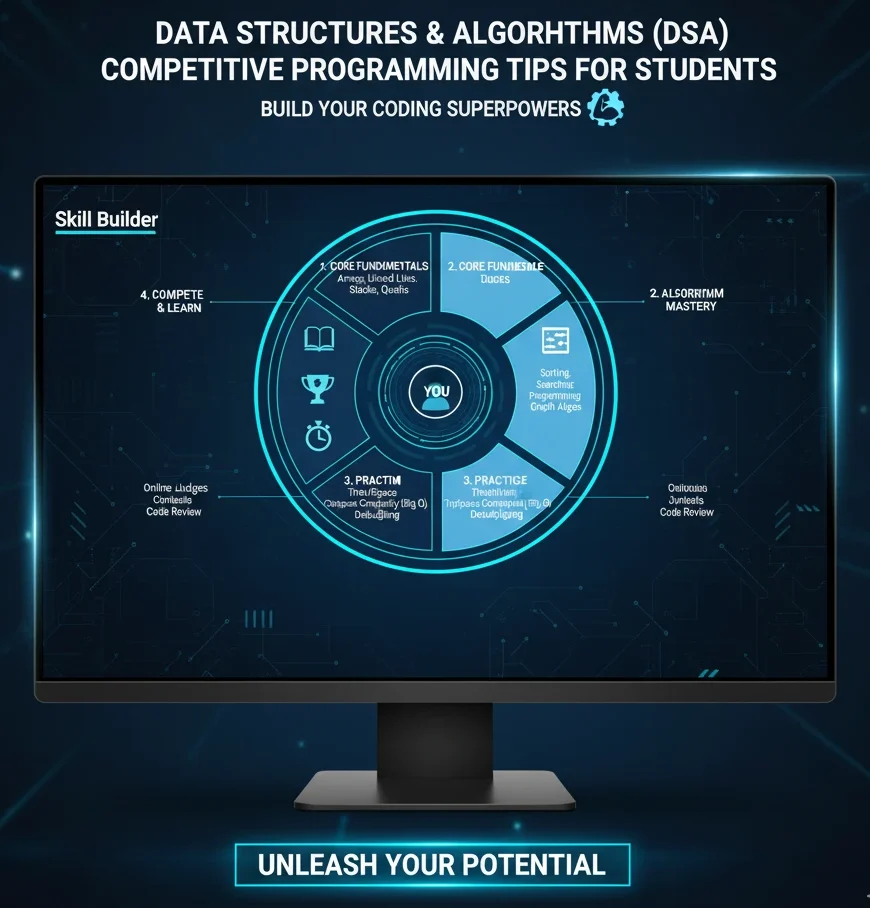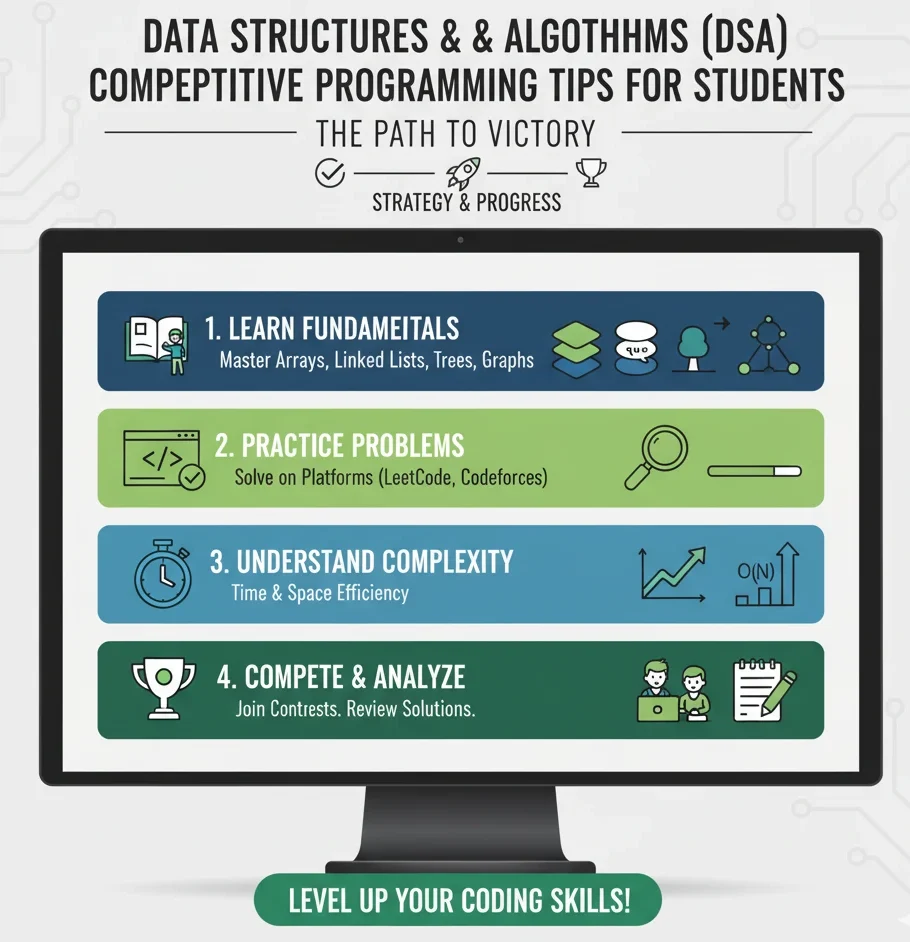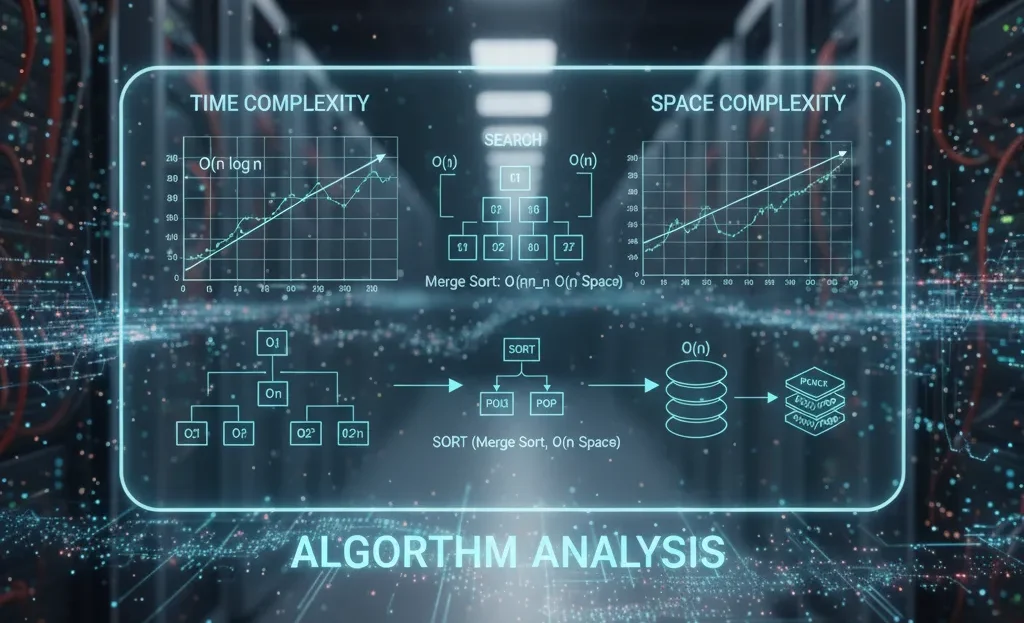Data Structures & Algorithms (DSA) – Competitive Programming Tips for Students

When you start stepping outside your normal programming classes, there’s one thing you’ll hear again and again — DSA (Data Structures and Algorithms). If you want to do well in coding contests or crack technical interviews, you can’t avoid it.
But honestly, for most students, DSA feels like a huge mountain at the beginning. Arrays, trees, heaps, graphs, recursion, dynamic programming — the list feels endless. It gets overwhelming. The trick is, you don’t need to learn everything at once. Get your basics straight, then just keep practicing step by step. If you’re just starting with DSA and competitive programming, here are some lessons I picked up that could save you time.
1. Get Your Basics Right
Don’t rush into graphs or DP on day one. First, make sure you’re comfortable with the simple stuff.
- Practice with arrays and strings first. Do simple exercises like flipping them around, moving elements, looking up items, or checking if a word exists inside another word.
- Stacks and queues — practice undo features or bracket matching problems.
- Linked lists — insert, delete, traverse until you’re confident.
- Recursion — even simple problems help, since it shows up everywhere later.
Think of these as your building blocks. Without them, advanced topics will feel impossible.
2. Don’t Just Memorize Solutions
One of the biggest mistakes I made early was just reading solutions and trying to remember them. That doesn’t help much. Instead, focus on why something works.
For example:
- Why use a hash map instead of an array for counting?
- Why does binary search make searching faster than a list?
When you understand the “why,” you’ll be able to apply the concept in new problems.
3. Pick the Right Platforms
There are hundreds of coding sites, but some stand out:
- LeetCode – good for interview prep.
- Codeforces – sharpens speed with contests.
- HackerRank – beginner-friendly.
- CodeChef / AtCoder – competitive problems.
Start with easy problems, then slowly move up. Don’t just chase problem counts. Focus on learning from each question.
4. Time and Space Complexity
In competitions, correct answers aren’t enough. Your code must also be efficient.

I once solved a problem with O(n²). It worked on small cases but failed on large ones. Later I optimized it with binary search to O(n log n), and it worked.
So always think about speed and memory.
5. Notice Patterns
Most problems aren’t brand new. They’re old ones in disguise. Learn to spot patterns like:
- Sliding window
- Two pointers
- Divide and conquer
- Dynamic programming
Once you recognize them, solving gets easier.
6. Join Contests Even If You’re Not Ready
Don’t wait until you “finish the syllabus.” I joined my first Codeforces contest without much prep and only solved one problem. It felt terrible, but I learned a lot just by looking at editorials and other people’s code. Every contest will teach you something.
7. Build a Routine
You don’t need to grind 8 hours daily. Consistency matters more.
- Solve 1–2 easy problems every day.
- Spend weekends on medium ones.
- Once a week, try a hard one.
This way, you improve without burning out.
8. Learn to Debug
Debugging is part of the process. Don’t skip it.
When something breaks, don’t panic. Just print stuff out, test with tiny inputs, or walk through your code step by step. Every bug you squash makes you a little better.
9. Learn From Others
There are tons of people coding out there. From blogs to YouTube to forums, you can always pick up new ideas. Don’t just copy though. Use their methods to improve your own problem-solving style.
Final Thoughts
DSA is the heart of competitive programming. Don’t just try to mug up formulas. In the beginning, choosing the right approach for a problem feels confusing, but the more you try, the easier it gets.
Start with small problems. Just keep solving problems, even if you mess up a lot. Over time, your thinking gets sharper, you’ll write code faster, and coding tests won’t feel as scary.
So open your editor today and try one problem. That’s how the journey begins.

